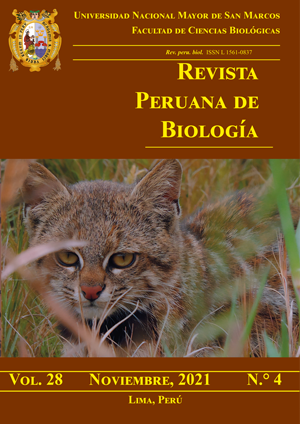Distribution of the genus Tityus Koch, 1836 (Scorpiones: Buthidae) in the city of La Plata (Argentina)
DOI:
https://doi.org/10.15381/rpb.v28i4.21154Keywords:
Tityus confluens, Tityus carrilloi, Synanthropic, scorpions, Scorpionism, Urban arachnidsAbstract
In the city of La Plata occurs the genus Tityus with records dating back to 1943. The territorial distribution of the genus Tityus in this city and its expansion was studied based on inquiries received at the CEPAVE Arachnology Laboratory from individuals and public and private institutions. 189 inquiries were received from 2005 to 2020. The QGIS program was used to geolocate each scorpion with urban layout layers and storm drains. For the spatial analysis of distribution, a home range of one hectare per individual was considered to calculate the area and in the cases of areas of overlapping influences during the same year, the area was considered as their union. The genus Tityus in the city of La Plata is represented by the species T. carrilloi and T. confluens, both of health interest and of synanthropic habits, which occupy two different well-defined areas. The analysis of the independent dispersion in the two zones would indicate that they could use the drains to disperse, and since they are unconnected there would be no flow of scorpions between both zones. The colonization of these species in the study area was strengthened for T. confluens as of 2005 and for T. carrilloi as of 2011. The highest records are in the warm months, from January to April, the latter being of higher value. September is the only month without complaints. The expansion rate calculated was 4.42 ha/year.
Downloads
References
Bibbs CS, Bengston SE, Gouge DH. 2014. Activity trends and movement distances in the Arizona bark scorpion (Scorpiones: Buthidae). Environmental Entomology 43(6):1613-1620. https://doi.org/10.1603/EN14148
Blanco G, Laskowicz R, Lanari L, Scarlato E, Damin C, Tito EH de, Roodt AR de. 2016. Distribución de los hallazgos de escorpiones en la Ciudad de Buenos Aires en el período 2001-2012 y sus implicancias sanitarias. Archivos Argentinos Pediatría 114(1):77-83. https://doi.org/10.5546/aap.2016.77
Diputados C De. 2014. Período 142o La Plata, 13 de agosto de 2014 9a. Reunión DIPUTADOS PRESENTES: 9a. SESION ORDINARIA PROVINCIA DE BUENOS AIRES [Internet]. [accessed 2021 May 21]. https://intranet.hcdiputados-ba.gov.ar/diarios/diario1429.pdf
Francke OF. 2008. A critical review of reports of parthenogenesis in Scorpions (Arachnida). Revista Ibérica Aracnología 16(c):93-104.
Maury EA. 1970. Redescripción y distribución en la argentina de Tityus trivittatus Kraepelin 1898 (Scorpiones, Buthidae) comentarios sobre sus hábitos domiciliarios y su peligrosidad. PHYSIS 29(79):405-421.
Maury EA. 1997. Tityus trivittatus en la Argentina Nuevos datos sobre distribución, partenogénesis, sinantropía y peligrosidad (Scorpiones, Buthidae). Publicaciones de extensión cultural y didáctica del Museo Argentino de Ciencias Naturales "Bernardino Rivadavia" 24:1-24.
Moyano RD. 2008. Aracnoidismo. Arañas y escorpiones de importancia Médica en Argentina. 1ra ed. Literature of Latin América LOLA, editor. Buenos Aires.
Ojanguren-Affilastro AA, Kochalka J, Guerrero-Orallana D, Garcete-Barrett B, de Roodt AR, Borges A, Ceccarelli FS. 2021. Redefinition of the identity and phylogenetic position of Tityus trivittatus Kraepelin 1898, and description of Tityus carrilloi n. sp. (Scorpiones; Buthidae), the most medically important scorpion of southern South America. Revista del Museo Argentino Ciencias Naturales, nueva serie 23(1):27-55. https://doi.org/10.22179/REVMACN.23.714
Ojanguren-Affilastro A, Bizzoto C, Lanari L, Lenicov MR, Roodt A de. 2019. Presencia de Tityus confluens Borelli en la ciudad de Buenos Aires y expansión de la distribución de las especies de importancia médica de Tityus (Scorpiones; Buthidae) en la Argentina. Revista del Museo Argentino de Ciencias Naturales nueva serie. 21(1):101-112. https://doi.org/10.22179/REVMACN.21.638
Ojanguren-Affilastro, A.A. 2005. Estudio monográfico de los escorpiones de la República Argentina. Revista Ibérica de Aracnología 11: 75-246
Roewer CF. 1943. Úber eine neuerworbene Sammlung von Skorpionen des Natur-Museums Senckenberg. Senckenbergiana. 26(4):205-244.
de Roodt AR. 2014. Comments on environmental and sanitary aspects of the scorpionism by Tityus trivittatus in Buenos Aires City, Argentina. Toxins (Basel) 6(4):1434-1452. https://doi.org/10.3390/toxins6041434
de Roodt AR, García SI, Salomón OD, Segre L, Dolab JA, Funes RF, De Titto EH. 2003. Epidemiological and clinical aspects of scorpionism by Tityus trivittatus in Argentina. Toxicon 41(8):971-977. https://doi.org/10.1016/S0041-0101(03)00066-7
de Roodt AR, Lanari LC, Remes-Lenicov M, Cargnel E, Damin CF, Greco V, Orduna TA, Lloveras S, Desio MA, van Grootheest JH, et al. 2019. Expansión de la distribución de escorpiones del género Tityus C. L. Koch 1836. Acta Toxicológica Argentina 27(3):109-119.
Toscano-Gadea CA. 2004. Confirmation of parthenogenesis in Tityus trivittatus Kraepelin 1898 (Scorpiones, Buthidae). The Journal of Arachnology 32:866-869. https://doi.org/10.1636/S03-21.1
Downloads
Published
Issue
Section
License
Copyright (c) 2021 Luis Alberto Giambelluca, Sandra E. González , Alda González

This work is licensed under a Creative Commons Attribution 4.0 International License.
AUTHORS RETAIN THEIR RIGHTS:
a. Authors retain their trade mark rights and patent, and also on any process or procedure described in the article.
b. Authors retain their right to share, copy, distribute, perform and publicly communicate their article (eg, to place their article in an institutional repository or publish it in a book), with an acknowledgment of its initial publication in the Revista Peruana de Biologia.
c. Authors retain theirs right to make a subsequent publication of their work, to use the article or any part thereof (eg a compilation of his papers, lecture notes, thesis, or a book), always indicating its initial publication in the Revista Peruana de Biologia (the originator of the work, journal, volume, number and date).






